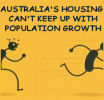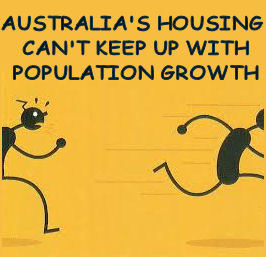Housing Affordability Senate Inquiry Report just released - Comments and submission by Robert Braby, economist
 Candobetter.net Editor: Article updated with full submission included and relabeling of table. The Commonwealth Senate released its long-awaited report on housing affordability on 8 May last, conveniently a few days before the release of the Federal Budget. The 461 page report examined, inter alia, the many supply and demand factors which impact on housing prices and affordability, and acknowledged that supply was not keeping up with demand – an obvious and major cause of rising house prices. But the emphasis of its recommendations was that the solution lay in increasing supply rather than in reducing demand. The elephant in the room, namely population growth, although mentioned in several submissions, hardly featured in its recommendations. This is not surprising, given the reluctance of politicians to face up to the obvious but politically awkward issues of immigration and birth rates, especially with the high level of influence exerted by vested business and property interests (including the recently revealed large number of politicians who own investment property).
Candobetter.net Editor: Article updated with full submission included and relabeling of table. The Commonwealth Senate released its long-awaited report on housing affordability on 8 May last, conveniently a few days before the release of the Federal Budget. The 461 page report examined, inter alia, the many supply and demand factors which impact on housing prices and affordability, and acknowledged that supply was not keeping up with demand – an obvious and major cause of rising house prices. But the emphasis of its recommendations was that the solution lay in increasing supply rather than in reducing demand. The elephant in the room, namely population growth, although mentioned in several submissions, hardly featured in its recommendations. This is not surprising, given the reluctance of politicians to face up to the obvious but politically awkward issues of immigration and birth rates, especially with the high level of influence exerted by vested business and property interests (including the recently revealed large number of politicians who own investment property).

You can read the report in the following link: http://www.aph.gov.au/Parliamentary_Business/Committees/Senate/Economics/Affordable_housing_2013/Report
My own submission to the housing inquiry argued that it is virtually impossible for supply to keep up with population growth, and that population growth is a major cause of the growing inequality between rich and poor. Read the submission below.
Submission to Household Affordability Inquiry by Bob Braby 19 March 2014
As the submissions to this inquiry indicate, there is a range of factors that can affect housing affordability in the short and medium term. But it is the long term effect of population growth that must be addressed if there is to be any lasting improvement in housing affordability. Short term band-aid measures are not sustainable. For example , increasing the supply of residential land on the urban fringe may enable the supply of housing to increase for a time , but it will also reduce the supply of raw land and eventually show up in higher land prices - and factored into future housing costs. Likewise, grants to first - home owners might provide some temporary relief , but will be self defeating to the extent that they also increase demand and house prices.
It is like chasing your hat on a windy day ; just as you think you have caught it, it blows further away . You will only catch it when the wind stops.
The link between population growth and property prices is well established in research studies, although denied by those with vested interests. Elementary supply and demand theory supports these results. Supply cannot keep up with increasing demand because:
1. The supply of raw land is fixed by nature.
2. The supply of serviced land is subject to environmental constraints ; for example, in Melbourne by Port Phillip Bay and the Mornington Peninsula in the south, the Dandenong ranges in the east and the Yarra valley in the north-east .
3. Development of broad acres requires rezoning to residential, but governments choose to restrict this to prevent urban sprawl.
4. Most people prefer to live close to the CBD rather than on the urban fringe, to take advantage of recreational, cultural and sporting facilities and employment opportunities. But the supply of vacant land in the inner and middle suburbs is very limited. In addition to the effect on land prices, this may lead to increased density in the form of high-rise development with increased building costs (per unit of net floor area), thus exacerbating the effect on affordability.
The effect of these various supply constraints is a steady increase in real land prices over time, as illustrated in some of the submissions to this inquiry and in a study by myself. Note also the high correlation between population size and land prices in our capital cities, with the exception of Darwin. But Darwin is bound by water on three sides and subject to severe environmental constraints as mentioned above.
The net effect of population growth is therefore a downward effect on household affordability . Worse, increasing house prices flow on to higher rents, with low-income people locked out of the housing market and trapped in a vicious circle of rent dependency and poverty. These unfortunate people do not share fully in the benefits of productivity growth, because improved wages over time are offset by higher rents. This can be illustrated by the following table, which shows three categories of people who may or may not benefit from economic growth.
[Editor comment: title of table changed 22 May 2015 to correct a transcription error.]
People who are employed and own their own house (col.2) benefit from productivity growth and are insulated from rising property prices. Those who are employed but cannot afford a house (col.3) benefit from productivity growth , but these benefits are eroded by increasing real rents induced by population growth.
Pensioners who do not own their own home (col .4 ) lose both ways and are at the mercy of government.
Governments need to drastically rethink the harmful effects of population growth, not only on housing affordability but also on the built and natural environment.
Robert Braby
19.3.2014


Recent comments